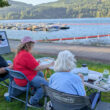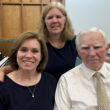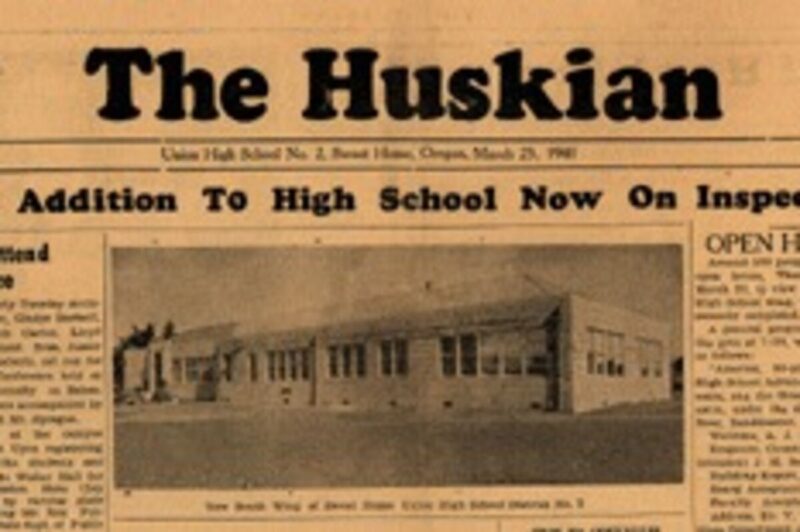Sean C. Morgan
Sweet Home High School has undergone several expansions throughout its history, generally expanding westward with each new project.
“The front of the building is just the same as the east end of it,” Blair Smith, who graduated with the Class of 1946, said of the recently demolished portion of the building. “It’s just kept coming to the west, getting bigger, then that last one went to the south.”
The southern portions of the high school, finished in the 1970s, will be remodeled. The area houses most of the school’s classrooms and will continue to do so.
Clinton Bennett, Class of 1941, provided a March 25, 1941 copy of The Huskian, which talked about the completion of the high school’s newest addition, now demolished.
“Around 500 people attended the open house, Thursday evening, March 20, to view the new Union High School wing, which has been recently completed,” The Huskian story said. The story outlined a program, including a performance by a 90-piece ensemble, including advanced band, orchestra and the grade school orchestra. It also included addresses by A.J. Sportsman, County School Supt. J.M. Bennett, C.N. Freeman, E.L. Scholl and Dr. V.D. Bain of the State Department of Education.
Visitors were given tickets directing them to different rooms to prevent congesting of too large a group in one room. Four 15-minute classroom presentations were held, and visitors were able to visit room to room to see work exhibitions on display i n art, manual training, journalism and English.
The area just finished was the recently demolished face of the high school, perhaps half of its recent length, beginning at the east end where administrative offices were located.
Sweet Home Union High School was formed in 1912. A 1976 special section of The New Era explained that it formed after several discussions caused “near riots.” The union district was formed from Sweet Home, Foster, Pleasant Valley, Moss Butte, Sunnyside, Liberty, Cascadia, Greenville and Cowling on Sept. 30.
According to one report, makeshift high school classes were given in 1910. The first graduating class came in 1915, with three graduating. Classes were initially held in the Christian Church while plans for construction of a high school building continued. T.W. Van Fleet was a faculty of one the first term at a salary of $60 per month.
The new building was under construction in 1913 at a cost of $4,000 on its current site. The grounds included three acres. By 1914, the building was just about done. The school had 26 students and two teachers. The building was expanded as the school expanded to more than 145 students in 1933.
A new building was approved in 1934. The first unit of the building was completed in 1935, with expansion continuing through the 1940s. The first unit included a boiler room, a library-study hall and six classrooms at a cost of $50,000.
Two more classrooms and a cafeteria cost $28,000. A third unit, four classrooms and one wall of the gym cost $84,000. A fourth unit, five classrooms and the gym, in 1948, cost $226,000.
The gym replaced another that stood separate from the rest of the high school.
That old gym was just like it is now, Bennett said. It was used for community events and meetings. It was located about where the cafeteria sits now.
“Right across the street from the high school was a little grocery store you could get candy bars or soda pop,” Bennett said.
A fifth unit, the auditorium, was completed in 1950 at a cost of $76,000.
By the mid-1950s, the high school covered 90,000 square feet and cost nearly $500,000.
Further improvements continued throughout the 1960s and into the 1970s, with a new autoshop in 1970. The south area was built up between 1963 and 1971.
The building was renovated and dedicated again in 1976.
“Some of us didn’t pay too much attention,” Smith said. “We just wanted to play sports.”
At the same time, the school has always provided an opportunity for a good education to those who wanted it, Smith said.
“There was no such thing as a school bus,” Smith said, but students were reimbursed based on mileage. Smith used to ride to school with William Weber. Those in the carpool would give him their checks.
Bennett lived in the country, about where Camp Attitude is now located on Highway 20 east of Sweet Home.
The school had about 120 students when he attended, about 30 per class, he said. The school day consisted of six classes and a study hall period.
“We had classes,” Bennett said. “We had sports. We didn’t have all the field trips.”
The school had one coach and one assistant for football, basketball, boxing, baseball and track. There was no swimming then.
“We didn’t do too bad,” Smith said. “Of course, when we played Albany and Lebanon, we didn’t do too good.”
“Old George Edwards taught us that if you make a touchdown against Corvallis, you did all right,” Smith said. “You didn’t have to be the state champion to have a good team.”
As in the past, tearing the high school down hits home for Smith.
“That was my old school,” he said. “It’s had a lot of growth over the years, and I think we’ve kept current with our education facilities.”
Smith has one bit of advice for high school students today.
“Take advantage of your young years here,” Smith said. “Have fun, but get an education too. There’s no excuse not going to college.”
In his experience, those that take high school and college seriously have the most success.





